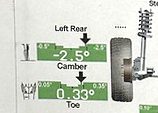
If you have ever owned a Tesla model S or X of the first generation 2012-2020 you will experience and expensive fix in your future. At some point you will need front half shafts. (CV Joints). The symptom is the front of the car shaking violently under heavy throttle. Typically the car drives fine at normal loads but with heavy throttle the vibration appears. This is inevitably the front half shafts wearing and wobbling out of round due to the high torque loads. Yes, there is a service bulletin and yes there are new parts, but there are still issues.

Here is some relatable stock car racing knowledge. Once upon a time N-car changed the rules about ride heights. They used to require cars to have high heights in the garage and during inspection. 8″ high in the rear! This was a problem as cars needed to be low for best performance, but not too low they hit the ground. Many tricks were used to achieve this and it usually required huge libraries of very expensive springs to achieve. Eventually the rule making body changed the rules and allowed cars to go out at any height they wanted. Teams quit making their cars high in the garage as it was an unnecessary complication. Yay, money saved on springs that could be spent in other areas!
The unintended consequence was the cars started randomly vibrating! (oops)

We narrowed down the shaking to the driveshafts. Weird. This was crazy. The new lower heights actually made the driveshafts more straight. Things should be better! Logic no longer applied. What could have changed? We didn’t change our parts. We still have the same transmissions, the same driveshafts and the same rear ends. What in the world was going on? Many teams were confused, including the sanctioning body.
The parts didn’t change. The rules changed. With the new rules race cars did not travel vertically like they used to.
Previously the cars had huge height changes every time they would go out on the track. This 8″ of vertical travel would result in an longitudinal inch movement of the yoke in and out of the transmission. This frequent large movement would inevitably lubricate and work the splines of the yoke. This movement would keep the yoke splines properly engaged and wear more evenly.

Without height changes, there was no longitudinal change on the yoke splines. This caused the yoke to wear faster in one spot as it always ran in the same spot. 900hp of heavy load is hard on components. In the corners of the track the car would see a torque reversal. As the pieces wore, on this reversal the yoke would get the splines out of whack and orbit a bit. This orbiting was causing mind shaking vibration to the point that shifter handles started to break off the transmission. (This is a very bad thing for a race car driver… not to mention the handles)
Through no fault of their own there was a new “normal” causing many drivers to drop out race after race. There was a behind the scenes race to engineer a solution to the problem.
This was a complicated problem. Many prominent teams spent millions on this issue. It took months for many teams to figure out where the vibration was coming from and curiously what was actually causing it. Luckily we were on it and things were better for us quicker than others.

So… Back to the Tesla. There is a very similar phenomenon occurring on these front half shafts. Once they are worn, they can orbit and you get a case of the shakes.
Let me say this. Almost never is there a problem with the rear shafts. Why is this? What is the big difference between the front and rear of the car? The rear has more power? Shouldn’t it wear first?
Wear is a function of overall angle and torque on the half shafts. Overall angle? Yes the angle has a much bigger effect than the overall power. The front tires steer. The back tires do not. This is the main reason why the fronts are usually the culprit. Yes there is more overall angle on the front caused by the geometry and the front ride height but the big culprit is steering and the jack shaft.
This is why even when lowered those that have lowered to “save their half shafts” continue to have problems with their front shafts shaking. It’s the overall angle and high torque with high steering angles that are causing the most wear. The issue has more to do with the driver than the ride height.
Our advice is to not go crazy when pulling out into traffic or when making hard turns. Simply, “Aim before firing” is good advice. You can save your money for more tires instead of half shafts.

The Tesla half shaft fixes are improvements but are not really fixes. Hang in there. We are working on a better solution.
Tesla does have their newer vehicles encourage lower heights more. It is a trade off to save the half shafts (to some degree) but it does have the effect of radically sacrificing tires… Save your tires with our camber arm kits for 2012-2020 Tesla S/X vehicles or our palladium camber kit for 2021+ Tesla S/X.



















